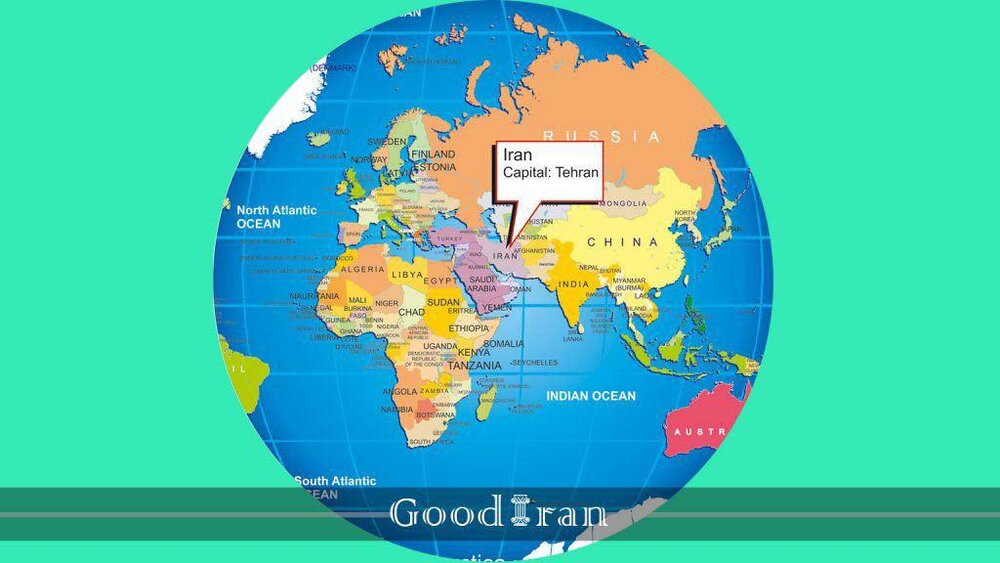Iran On Map

Iran is a country in Western Asia, the Middle East to be exact. Turkey and Iraq are its neighbors to the west, Pakistan and Afghanistan to the east, Armenia and Republic of Azerbaijan to the northwest, and Turkmenistan to the northeast. Iran shares maritime borders with some countries to the north by the Caspian Sea and to the south by the Persian Gulf and the Gulf of Oman
Are Iranians Arabs?
In seventh century, Arabs invaded Iran. Sassanid Empire was defeated by Rashidun Caliphate which led to gradual Islamization of Iran by their swords, targeting the Zoroastrian majority. They killed whoever didn’t convert into Islam, burnt libraries and destroyed temples, also tried hard to change the people’s local customs to Islamic and their language to Arabic, they were not very successful though. Iranian’s language was and still is Persian or Farsi, but was so much influenced by Arabic. This was the beginning of the following, prolonged conflicts between Persians and Arabs that later resulted in the emergence of Shia Islam and reunification of Iran as an independent state by the Safavid dynasty.
Religion
Zoroastrianism was once the major religion in Persia, but after the Muslim Arabs conquest of Iran, they propagated Sunni Islam throughout the nation. From 1501, the Safavids began consolidating their control over Iran and give it a distinct identity among the Islamic nations, where most of the Persian population were still Sunnis. On the other hand, the Safavids had to unify the whole nation to be able to counter the threats of their Sunni enemies or within the country. So they established Twelver Shiism as the official religion of their empire, marking one of the most important turning points in the history of Islam and Iran.
After the Safavids, Shia Islam remained the main religion in Iran, but lost its position as the official religion dictating the government policies until the 1979 Islamic Revolution of Iran which led to the extinction of the Pahlavi dynasty, the last kingdom, and the beginning of the political sovereignty of Islam over the nation.
Around 90% of Iranians associate themselves with the Shia branch of Islam, the official state religion, and about 9% with the Sunni and Sufi branches. The remaining less than 1% involves non-Islamic religious minorities, including Bahais, Mandeans, Yarsanis, Zoroastrians, Jews, and Christians. The latter three religions are officially recognized and protected, and have reserved seats in the Iran parliament.
Language
Because of Iran’s ethnic and social diversity, there are some different languages with many dialects and accents being spoken by the people including Persian or Farsi, Turkic (mostly Azerbaijani, some Turkmen, Qashqai, and Afshar), Kurdish, Gilaki and Mazandarani, Luri, Arabic, Baluchi, etc. As mentioned in the constitution, Persian is the Lingua Franca of Iran and the only language that must be used through all official government communications and educational system.
Culture and Art
Iranian culture is one of the oldest in the universe which has directly influenced cultures and people from the Far East to the West and it has one of the richest art heritages in world history and involves many disciplines including architecture, painting, weaving, pottery, calligraphy, metalworking and stonemasonry, etc. Iranian art has experienced several phases, but generally, it can be divided into two main phases: before and after Islam. The unique pre-Islamic aesthetics of Iran is manifested, for instance, in Persepolis or in the mosaic paintings of Bishapur. The Islamic era brought drastic changes to the styles and practice of the arts, at each dynasty with their particular view, influencing architecture and literature in particular. The Qajarid era was the last stage of classical Persian art, before modernism was imported and suffused into elements of traditionalist schools of aesthetics.
- Iranian food and Persian Rugs: Persians are believed to be the first people in history to weave carpets and Persian rugs have always been an inseparable part of the Persian culture and art. Besides, due to the long history of fine silk and wool rugs of Iran, Persian rugs are world famous as some of the most beautiful and precious rugs available.
-Women: Women have always played fundamental, crucial, and representative roles in the long history of Iran and maintained a high level of social status. The Sassanid princess Purandokht, daughter of Khosrau II, for instance, ruled the Persian Empire for almost two years. After Islamization of Iran, these roles began to decline, especially due to the compulsory Islamic Hijab i.e. women are bound to cover themselves up in presence of men. By the emergence of Pahlavi dynasty in 1925, which was the beginning of the modernization in Iran, women had once again the opportunity to regain their position in the society. Women could be elected to the parliament, appointed as judges and ministers in the cabinet, etc. Soon after the Islamic revolution of Iran in 1979, hijab was once again mandatory for women but this time it couldn’t disturb their social position. Iranian women now can possess almost anything men can.
-Hospitality: “Guest is God’s friend”. This is not only a Persian proverb, but also a belief among Iranians. They love guests and try their best, with no expectation, to have them feel at home. Tourists who visit Iran confess that they have never seen such a hospitality anywhere else.
Geopolitical Importance
Iran is located in Eurasia. As a linking area between the East and West, the country has been considered of great commercial and strategic significance throughout history. It was one of the bridges on the ancient trade network route, the Silk Road in the past and its proximity to the Strait of Hormuz, the only sea passage from the Persian Gulf to the open oceans through the Gulf of Oman, is now one of the main reasons of the geopolitical importance of Iran.
Leave a Comment